Where coinage was invented Population (Sartmustafa): 4,750
East of İzmir, the ruins of Sardis, the capital of King Croesus of the Lydians, stand in lovely countryside at Sartmustafa (Sart), near the small town of Salihli. It was here that the great Ottoman artist and museologist Osman Hamdi Bey suggested that archaeologists start digging and what they uncovered was enough to indicate that this had once been a hugely important city, albeit one whose stones had long since been carried away for reuse elsewhere.
Today there are two main areas of ruins to be visited: the main site with the synagogue mosaics and a separate site with the ruins of the Temple of Artemis.
Most of the finds from Sardis are housed in Manisa Archaeological Museum which has been closed for decades. Supposedly it was due to reopen (in a new location, I think) in 2023 but there has been no update on this.
Around the site
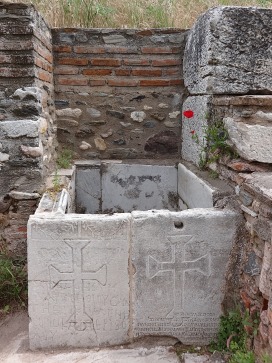 Today as you enter the main site along a stretch of Roman road you pass the slight remains of a series of shops in an area that has been described as a bazaar – great innovators, the Lydians are thought to have been the first people to set up permanent shops as opposed to market stalls. They would probably have been combined shop-houses since many of the items found inside them suggest a domestic purpose.
Today as you enter the main site along a stretch of Roman road you pass the slight remains of a series of shops in an area that has been described as a bazaar – great innovators, the Lydians are thought to have been the first people to set up permanent shops as opposed to market stalls. They would probably have been combined shop-houses since many of the items found inside them suggest a domestic purpose.
Sardis appears to have had a sizeable Jewish population. The shop-houses once backed onto a 3rd-century synagogue whose magnificent mosaic floor still survives (and now has a roof for its protection). One of the shops appears to have been owned by a man called Jacob.
Beyond the synagogue other remains are typical of other Classical-era sites and confirm that Sardis continued in importance long after the Lydians had been consigned to history. There are, for example, remains of a hamam and gymnasium, both of them dating back to the 2nd century AD and apparently destroyed during a Sassanian raid in 616.
The remains are by no means as impressive as those at Ephesus, but they are dominated by the magnificent marble-encrusted Court of the Hall of the Imperial Cult, dating back to 211, which has been partially restored to give some idea of its original size and splendour.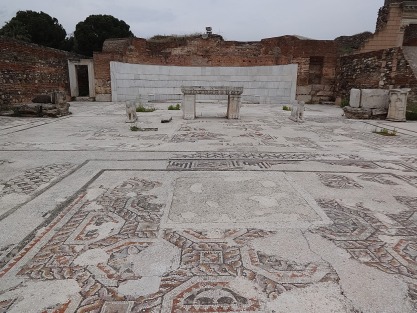
One of the Seven Churches of Asia Minor mentioned by St John in the Biblical Book of Revelation, Sardis must have been a huge town in its heyday and across the road from the main site stand pieces of the city wall with later Roman houses straddling them.
Near the site
For any trace of the Lydians, you need to leave the main site and head 1km south along the main road in search of the remains of a vast Temple of Artemis which is thought to have been built originally during the reign of King Croesus. At that time, it was probably one of the four largest temples of Asia Minor, rivalling in size the giant temple at Ephesus whose building costs were also borne by Croesus.
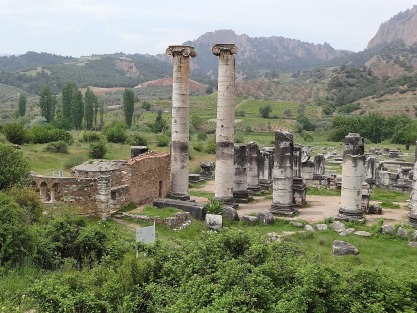 What is to be seen today dates back to a later remodelling, although the historian George Bean suggested that the unusually lofty column bases were a feature that should be traced back to the Lydians. A couple of inscriptions written in both Greek and Lydian were found here. There are also remains of a later Byzantine church.
What is to be seen today dates back to a later remodelling, although the historian George Bean suggested that the unusually lofty column bases were a feature that should be traced back to the Lydians. A couple of inscriptions written in both Greek and Lydian were found here. There are also remains of a later Byzantine church.
The walk to the temple takes you past the Pactolyus stream where the Lydians are thought to have electrum, a gold and silver alloy that they used to mint the first known coins in the reign of King Aylattes (r.635-585 BC).
The best evidence of the Lydian presence is to be seen north from the road running between Salihli and Sartmustafa in the form of the many tumuli scattered about an area called Bintepe (One Thousand Hills).
Believed to have contained the remains of the Lydian kings including Gyges, they are very like those around Gordion that contained the remains of the Phrygian kings, highlighting once again the links between the two cultures.
Some of these tumuli are absolutely enormous. That of King Alyattes is 69m high but measures a km around its base. Amongst those said to have laboured to build it a group of prostitutes are said to have been the most zealous.
In 1401 Tamerlane came rampaging through the region and that was the effective end of Sardis.
Sleeping
Although there is accommodation in Salihli, near Sartmustafa, it’s probably best to stay in İzmir and visit Sardis on a day trip.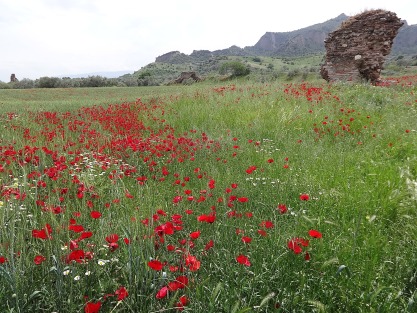 Scenery around Sardis in spring
Scenery around Sardis in spring
Transport info
There are frequent flights to İzmir airport and bus services to İzmir from all nearby towns. To get to Sardis, take a local bus from the upper level of İzmir otogar to Salihli and change to a bus to Sart.
Day trip destinations
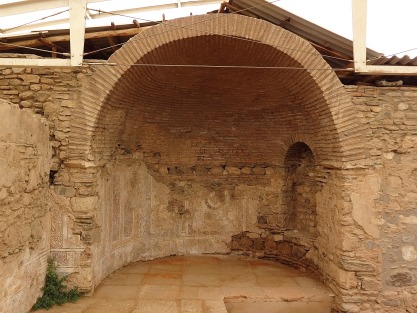 Neglected ruins of frescoed Roman house across the road from main site
Neglected ruins of frescoed Roman house across the road from main site


